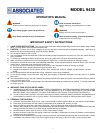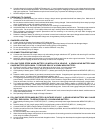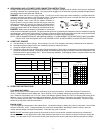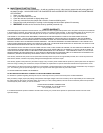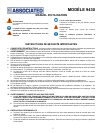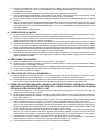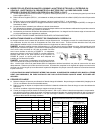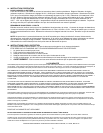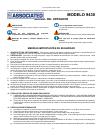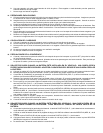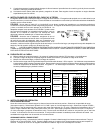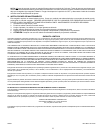
3
19. GROUNDING AND AC POWER CORD CONNECTION INSTRUCTIONS
Charger should be grounded to reduce risk of electric shock. Charger is equipped with an electric cord having an equipment
grounding conductor and a grounding plug. The plug must be plugged into an outlet that is properly installed and grounded in
accordance with all local codes and ordinances.
DANGER - Never alter AC cord or plug provided - if it will not fit outlet, have proper outlet installed by a qualified electrician.
Improper connection can result in a risk of an electric shock. This battery charger is for use on a nominal 120-volt circuit, and has a
grounding plug that looks like the plug illustrated in Figure (A). A
temporary adapter, which looks like the adapter illustrated in
Figures (B and C), may be used to connect this plug to a two-pole
receptacle, as shown in Figure (B), if a properly grounded outlet is
not available. The temporary adapter should be used only until a
properly grounded outlet can be installed by a qualified electrician.
DANGER - Before using an adapter as illustrated, be certain that
center screw of outlet plate is grounded. The green-colored rigid ear or lug extending from adapter must be connected to a properly
grounded outlet - make certain it is grounded. If necessary, replace the original outlet cover plate screw with a longer screw that will
secure adapter ear or lug to outlet cover plate and make ground connection to grounded outlet.
NOTE: USE OF AN ADAPTER IS NOT ALLOWED IN CANADA. IF A GROUNDING TYPE RECEPTACLE IS NOT AVAILABLE,
DO NOT USE THIS APPLIANCE UNTIL THE PROPER OUTLET IS INSTALLED BY A QUALIFIED ELECTRICIAN.
20.
LENGTH OF CHARGE
a. Test the battery for state of charge. Do not charge if it is over 75% charged or the battery is determined to be defective.
b. Set beginning amps charge rate for size of battery and state of charge per charts
c. Charge for length of time per charge,
d. Discontinue charge when the specific gravity of electrolyte reaches 1.260 or above. A temperature compensating hydrometer
should be used for this reading. Discontinue charge if the battery begins to gas excessively or when the temperature of the
electrolyte reaches approximately 120°F. Do not overcharge batteries. Overcharging results in excessive water loss and
eventual damage to the battery.
21.
OPERATING INSTRUCTIONS
TO CHARGE BATTERIES
Make the connections to the battery per the instructions in the previous sections. Set the Rate Selector (Top Switch) to
2A/12V - 6A/6V setting for lower charge rate. Set to 30/150A - 6/12V for higher charge rate and engine starting (6 and 12
volt). Determine if the battery is 6 or 12 volts. Set the Volt Selector (Bottom Switch) to 6 VOLT for charging and starting 6 volt
batteries. Set to 12 Volt to charge and start 12 volt batteries. DO NOT charge a 6 volt battery at a setting other than 6 Volt.
The 6 volt setting does not taper. The AMMETER will show the amount of current delivered to the battery. Length of charge
should be per the above chart and instructions.
ENGINE START
Turn off all lights and accessories in the stalled vehicle. Connect the charger to battery per previous instructions. Set the Rate
Selector to 30/150A - 6/12V. Charge the battery for at least five minutes before attempting to start the vehicle. Start the
vehicle with the charger connected to the battery. Follow the duty cycle on the unit.
NOTE: DO NOT
crank the engine more than 20 seconds in any five minute period; excessive cranking may overheat and
damage the starter. If the vehicle fails to start, while waiting for the starter to cool, allow the charger to continue to charge the
battery. Turn the switch to OFF and remove the AC power cord from the electric outlet before disconnecting the DC clamps.
%CHARGE
0-25
30
45
20
3035
55
2025
10
15
15 15
10
10
10 10
15 30 45 60 75 90
MINUTES
A
M
P
E
R
E
S
25-50
50-75
50-75
25-50
0-25
50-75
25-50
0-25
40 30
40 25 20
40 20
45
40 30 25
30 20 15
55 40
50 40 25
40 25 20
Cold Cranking Amps
Reserve Capacity
Ampere Hours
BATTERY SIZE
60
90
350
80+
100+
400+
40
60
275
BATTERY SIZE TABLE
LARGE
MEDIUM
SMALL
BATTERY SIZE
SMALL MEDIUM LARGE
CHARGE RATE Vs. MINUTES CHARGE
STATE OF CHARGE TABLE
STATE OF CHARGE
Specific Gravity
Open Circuit Voltage 6V
Open Circuit Voltage 12V
DEAD75% 50% 25%
1.225
6.2
12.4
1.185
6.05
12.1
1.140
5.95
11.9
1.110
5.9
11.8



